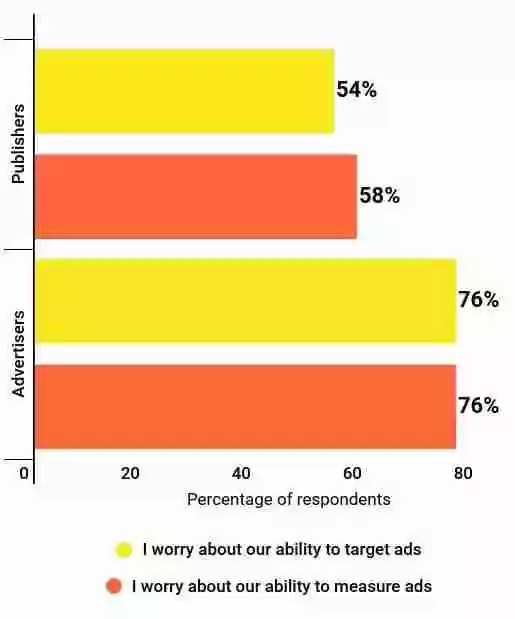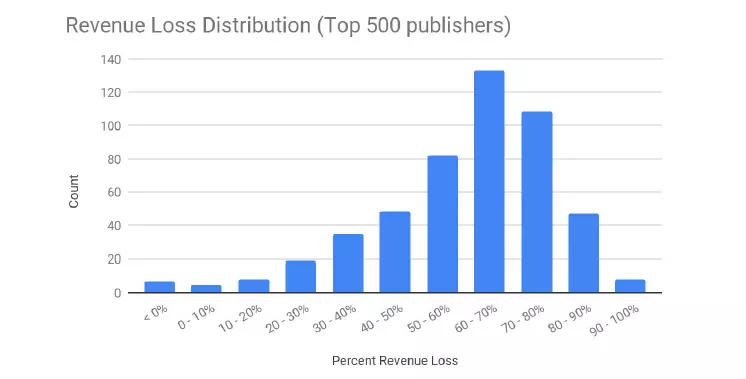Cookies aren’t just integral to identify and authenticate website visitors on the Internet. Since the early days of the web, publishers have had to rely on cookies to monetize their content by selling targeted ads.
But the way publishers use cookies in advertising campaigns is drastically going to change with the upcoming Google Chrome changes by the end of 2022. Although the cookie-blocking technologies were initiated by Apple’s Safari two years ago, Google’s announcement of blocking cookies is going to bring changes in the ad-tech industry.
Reason? The market share of the Chrome browser and its contribution to the ad revenue. As of June 2021, Google Chrome accounted for more than 64% of the global web browser market share.
Now that the change is coming, what does the crumbling of third-party cookies mean for publishers? Are there any other effective alternatives to third-party cookies? What’s the future of advertising from a publishers’ perspective? Let’s get the answers to all these questions in this article.
Table of Contents
The End of Third-party Cookies: A Brief Timeline
2017: Safari’s New Intelligent Tracking Protection (ITP)
Intelligent Tracking Protection was first introduced in 2017, but the challenges for publishers, advertisers, and ad-tech vendors came up with the ITP 2.1 update in 2019. In ITP 2.1, Safari purged most first-party cookies after 7 days and fully blocked all third-party cookies by default. In the last three years, Apple has made several changes to its ITP and has continued war against online tracking.
2019: Mozilla’s Enhanced Tracking Prevention (ETP)
Shortly after ITP, Mozilla announced that it would start blocking cookies and storage access from third-party trackers by default. As of today, Mozilla blocks all third-party cookies based on the disconnect.me trackers list.
2020: Microsoft’s Tracking Prevention (MTP)
Similar to Apple’s ITP and Mozilla’s ETP, Microsoft released Microsoft Tracking Prevention for its Edge browser at the beginning of 2020. The MTP promises to save the usage of users’ data and blocks third-party cookies from tracking users.
The changes made by the major web browsers have shuddered the plans of the whole advertising industry in the past three years. In the meantime, the user’s concern for digital privacy is not going away soon. According to Google, 19 million users per day visited their Google Account to adjust their privacy settings across various Google products in 2019.

Image Source: Google
And this growing privacy concern has led to multiple changes in anti-tracking measures of web browsers. Not only this, but it has also increased the number of data privacy regulations worldwide in the last couple of months. First, Europe’s ePrivacy Directive, then GDPR, CCPA, PDPA, and so on.
Now, almost every country in the world is thinking about users’ privacy more than ever before. In fact, searches for “online privacy” have grown globally by more than 50% Y-O-Y (Src). It may seem like that removing third-party cookies is intent on creating a safe environment for users. But, even digital powerhouses like Google know how badly it is going to affect publishers.
Impact of Blocking Third-party Cookies on Publishers
Third-party cookies have been the base for digital publishers for targeted ad serving and removing the cookies means they will no longer be able to:
- Apply frequency capping on their ads. As a result, publishers will serve repeated ads to the users and risk annoying them.
- Create an audience list and deliver personalized ads. As said by DoubleVerify in a statement, rather than showing users a sneaker ad because they were shopping for shoes two hours ago, they’ll get a sneaker ad because they’re reading about the World Cup (Src).
- Target and re-target the audience across the Internet whether it is for digital advertising campaigns or affiliate marketing.
- Measure the effectiveness of the ads especially cross-device conversions and view-through rate.
These limitations and the inability to identify users will make it harder for the publishers to monetize their traffic effectively. As per a report by Digiday, nearly 58% of publishers are worried about how they are going to measure the performance of their ads while 54% are worried about their ability to target the ads.

Image Source: Digiday.com
Besides, to understand how third-party cookies affect the ad revenue of a publisher, Google recently did a survey and found out that publishers lose ~52% of the programmatic revenue due to the absence of cookies.

”Since Apple and Firefox made changes to their browsers, 40% of all third party cookies have been wiped out. In the programmatic ecosystem, this means publishers are unable to personalize content or serve targeted advertising – their most profitable revenue stream – for almost half their audience.”
– Amit Kotecha, Marketing Director, Permutive.
While the exact impact of blocking third-party cookies is still unclear, we have got you the following recommendations to help you with the upcoming cookie-less days.
How Publishers Can Survive in the Cookieless Era?
Use Consent Management Platform (CMP) and Customer Data Platform (CDP)
Using a Consent Management Platform makes it easier for publishers to gather and manage consent on their websites. CMPs can ensure that users have transparency and know-how their data is controlled. So that you don’t have to worry about violating laws and can deliver personalized content and ads at the same time. Moreover, if you have some specific needs, then you can build your own consent management platform.
Also, in the last few months, publishers have increasingly shifted to Customer Data Platforms (CDPs) as they can provide advanced analytics and tools to collect and store first-party data. In a privacy-centric world, you can start with your direct-sold ad campaigns and use the first-party data to create a pseudonymous identifier for each user and apply frequency caps across different devices without the use of third-party cookies.
If you don’t have enough resources to start with a CDP, you can set-up a property-configured Google Analytics account to gain insights into audience, content, and other opportunities that can help you to better monetize your traffic. Many publishers have still restricted themselves to check page views, demographics, sources, or bounce rate in their Analytics dashboard. But you shouldn’t. In fact, you need to integrate your Analytics account to Google Ad Manager
“By linking Google Analytics 360 and Google Ad Manager, we were able to develop advanced audience-segmentation strategies for our advertisers. Building these new data-centric capabilities helped us greatly increase our CPMs.”
– Moch Rifki, Vice GM Marketing Digital & Print, KG Media (Src)
Provide Users Transparency and Control over their Data.
Around the world, there are several countries where regulations like CCPA, GDPR, etc. are taking place. So, be transparent about data collection and usage, and proactively take actions to comply with the data privacy laws and regulations. For example, check the ad personalization and data processing settings in your Google Publisher Tags (GPT) and if you’re serving non-personalized ads. You can simply do it by using the command:
googletag.pubads().setRequestNonPersonalizedAds(1)
Next step, make sure that your privacy policy page is up to date with the latest practices and guidelines of the latest version of GDPR, CCPA, COPPA, etc. Try to explain the content in your privacy policy in a simple language so that your users understand it easily.
Also, make the users know what data you are collecting, how it is going to be used, with whom you’re going to share the data, and why. And last, don’t forget to mention what values users are going to get if they permit you to use their information. Because this is how you’re going to prove yourself legitimate and different from your rivals.
Start Building Direct Relationships with Advertisers using First-party Data
With the upcoming changes in privacy laws and third-party cookies, first-party data has now become a golden opportunity for publishers. If you have been following the recent news in the publishing industry, chances are high that you know how the legacy publishers like The Washington Post, Wall Street Journal, The Telegraph, etc. have joined the bandwagon to take advantage of first-party data and target the valuable audience.
Here are some of the common practices that will help you to build relationships with your audience and collect first-party data.
Paid Subscriptions:
Paid subscriptions are one of the most popular methods as it can be used to collect data as well as monetize the readership. There is a downside as it acts as a barrier to increasing readership. But nowadays, there are several types of subscription models (metered paywall, dynamic paywall, etc.) available that can get you over the downside.
Besides, publishers can offer paid subscriptions with free trials that provide access to premium content for some time. Let’s take an example of The Times Inc. that has been relying on digital subscriptions since 2010. The publisher offered 10 free articles to every website visitor, and if they registered, they were allowed to read 5 more articles for free.
Typically, the publisher collected email addresses and names of the users who registered. Additionally, when the users registered, they were asked a few questions that helped the publisher to know their coverage interests. By collecting such information, the publisher charged higher to its advertisers without using third-party cookies.
Virtual Events:
Virtual events offer unique opportunities to users to engage with your content in a new and different way. And so far, virtual events don’t require the same costs as in-person events. VentureBeat, a tech publisher, is generating 50% of its overall revenue from events. According to VentureBeat, virtual events are more successful because more diverse attendees and speakers can join the event.
“With the huge success we’ve had with virtual events — over a quarter of a million attendees have tuned in from over 110 countries — we’ve realized that a significant portion of our attendees was not current NYT subscribers.”
– Jessica Flood, Managing Director, NYT Live
Use Contextual Data to Connect Buyers with Audience
Contextual data is one of the easiest ways to create content that resonates with the audience. Various publishers invest a lot in adding granularity in contextual signals to add more value and create opportunities for the ad inventory. This helps the publishers to charge higher CPM for the specific audience.
For some, contextual might seem less effective and scaled. But publishers such as The Washington Post, Insider Inc., and The New York Times are investing in contextual advertising as they believe it is an effective way to deliver relevant ads to the right audience.
Furthermore, contextual advertising has evolved in the past few decades. And today, contextual is just not about keywords or context. AI-based contextual solution providers can help you target your audience by semantics, their emotions, preferences, and many more.
“We are starting to understand how ads perform in different contexts for certain audiences. Say you’re advertising insurance, it generally would work better in a more serious article. If an ad runs in along a story with the same emotional context, there’s a 60% greater chance for someone watching your videos.”
– Ben Walmsley, commercial director of publishing at News UK (Src)
So, why not try contextual targeting? You can start with Google Ad Manager’s key-value targeting. By using key-values, you can understand your audience better and sell your inventories. Here’s a guide to key-value targeting that you may find useful.
Keep Yourself Updated with the Upcoming Frameworks
After Google announced that the third-party cookies would be phased out in two years, IAB and IAB Tech Lab introduced Privacy Rearc, a new framework for targeted advertising without third-party cookies.
Project Rearc:
With the Project Rearc, IAB Tech Lab has proposed standards that will be focused on first-party data and it will allow the buyers to target the users via Universal ID or login (encrypted and voluntarily provided email).
However, users will always have full control over their data. Though it is too early to comment on the relevance of the Project Rearc, it is definitely going to be helpful in a cookie-less industry to some extent. So, keep yourself updated with the changes getting introduced in Project Rearc to take advantage of the framework when it gets rolled out.
Google’s Privacy Sandbox:
Privacy Sandbox is another proposal to help the publishers deliver targeted ads and monetize content in a post-third-party cookie world. To put it simply, Privacy Sandbox is a set of web standards that are designed to protect users’ privacy while still giving publishers the ability to serve targeted ads and measure ad performance.

Image Source: Lotame
Similar to Project Rearc, there is no proof of the effectiveness of Privacy Sandbox as Google is still working on it. But publishers do believe that it could be an alternative to third-party cookies.
“The general feeling is that [Google Privacy Sandbox proposals] make sense”
– Bedir Aydemir, Head of Audience and Data, News UK Commercial
What’s Next?
Given the importance of third-party cookies to the publishing industry, it is understandable to be worried about what the future holds. Although Google has announced the phase-out of cookies, the entire ad-tech industry is working towards finding effective solutions to replace the third-party cookies, we cannot foresee if the existing solutions will level up the targeted online advertising. Let us know your thoughts in the comments below.























